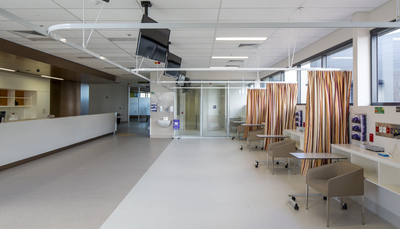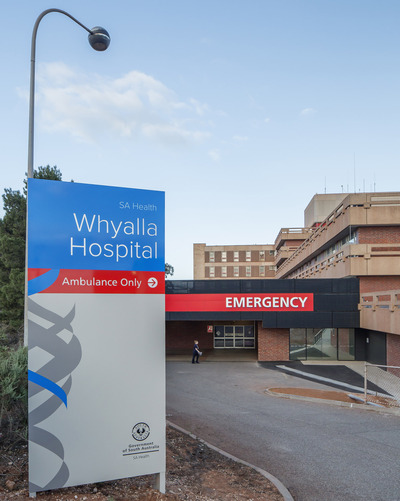How can design help alleviate overcrowded emergency departments?

Excessively long lines that stretch out the door, patients on trolleys blocking exits, nurses struggling to keep up with triage and bored, impatient families waiting hours to be seen. No — this has nothing to do with the coronavirus pandemic.
The overcrowding of Emergency Departments (EDs) has been a serious issue facing many Australian hospitals for at least the last decade. It’s a complex problem resulting from multiple issues, from inadequate funding, to doctor shortages and a scarcity of beds. And while architects have no control over those particular problems, what many people don’t realise is that some of the overcrowding problems can be alleviated through design.
Designing healthcare delivery
A great deal depends on whether an architect is designing a building to accommodate healthcare activities or whether the architect is designing the healthcare-delivery system. At Hames Sharley, our healthcare architects are trained to work with client representatives to design the entire healthcare-delivery system, not just the building.
By understanding the way hospitals work and the pressures they face, healthcare architects can design EDs that are better equipped to deal with the growing influx of patients. With smart design techniques aimed at maximising workflow and minimising cross infection of diseases, it’s possible to help decrease the chance of errors and create more efficient space for beds, ultimately helping to reduce overcrowding.
Life-saving efficiencies
Efficient EDs are crucial when it comes to providing patient care, but it’s much more than just providing a satisfactory patient experience. Overcrowded and inefficient EDs can lead to patients being left untreated, suffering needlessly or overlooked, and in some situations, can increase the chances of patients dying. It’s quite literally a matter of life or death.
It is imperative that EDs are designed to maximise optimal workflow. Quick and efficient evaluation, treatment and discharge of patients to home or a treatment bed helps to reduce overcrowding. The seamless flow of patients also allows staff to better provide treatment — increasing their effectiveness and helping to reduce errors. To achieve this, ED design needs to be re-imagined to create a process that segregates patients and moves them through quickly, despite the limited number of available doctors.
Smart design solutions
A lack of space and limited beds are some of the key reasons EDs cite for overcrowding. However, smart design solutions can provide EDs with more bed space without having to extend the hospital. Appropriately sized and located waiting areas — along with the features medical staff need to effectively and efficiently treat patients — are key aspects that can be improved through intelligent design.
Key components to improve ED design include:
Minimising exposure to disease: In addition to maximising throughput and increasing efficiencies, EDs need to be patient focused and designed to minimise cross infection and exposure to disease. While this has always been a crucial design requirement for hospitals, the COVID-19 pandemic has highlighted its importance. In Australia, the pandemic has resulted in some mandated changes to the ED layout and flow, including factors such as ensuring waiting areas are of adequate size to encourage physical distancing and, where possible, segregating those who display signs of COVID-19 symptoms into a different waiting zone.
Design of healthcare-delivery systems: Architects with experience and understanding of how EDs fit into the ‘Model of Care’ delivered by hospitals can assist in designing the overall healthcare-delivery system to improve the design of EDs.
Wayfinding: Hospitals are complex buildings that can be difficult to navigate. Providing clearly marked and easy-to-follow paths of movement can improve patient and visitor flow, reducing congestion.
Improved room design: Space is at a premium in hospitals — especially in EDs — so it’s imperative that each room is designed to maximise space. Rather than looking to build more rooms, reorganising existing space can result in more efficient flowthrough. This is not a one-size-fits-all approach — each ED needs to be analysed and assessed to determine the best room design to achieve maximum efficiencies.
Improved staff scaling: Rethinking the way EDs are designed to utilise staff can help to improve the way resources are managed. When EDs are designed in traditional pod configurations, each pod requires a full contingent of staff regardless of the number of patients in each one. But when an ED is more linear in design, staff can be assigned incrementally, helping to remedy staffing issues.
Flexible spaces: A lean design approach can help improve ED staff efficiency by creating spaces that are flexible and have multiple uses. Whether it’s creating new spaces or renovating old spaces, it’s important to accommodate for flexibility in the design to allow for high patient numbers and to provide overflow capacity when required.
In some cases, designated areas for staff to put on personal protective equipment (PPE) may be required, while in Victoria, detailed cohorting and isolation guidelines have been introduced. To minimise the risk of transmission between patients, and also between healthcare workers, strict screening, triage, and clear signage and flowthrough have been introduced as a way to curb transmission.
Focus on the design of healthcare-delivery systems, not just the building
If 2020 has taught us anything, it’s that Australia needs an efficient and effective public healthcare-delivery system. Although our hospitals and medical staff are some of the best in the world, the issue of overcrowding has been plaguing many EDs across the country for the best part of a decade.
With the need to maximise workflow and minimise cross infection highlighted during the pandemic, hospitals should now look to redesigning their EDs by focusing on the design of the healthcare-delivery system, not just the physical spaces required. By using this holistic approach, efficient EDs will boast shorter wait times, faster diagnoses, less strain on resources and, ultimately, higher patient satisfaction.
Originally published here.
Local spirit: new Footscray Hospital, Melbourne
The new Footscray Hospital will be partly a result of local community campaigning —...
Designing with compassion
Balancing calm, serene spaces with acute facilities, the Anam Cara House is a unique hospice...
La Trobe Private Hospital reopens after redevelopment
La Trobe Private Hospital has reopened its doors following a complete redevelopment, giving...













